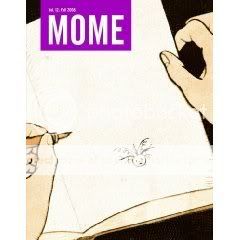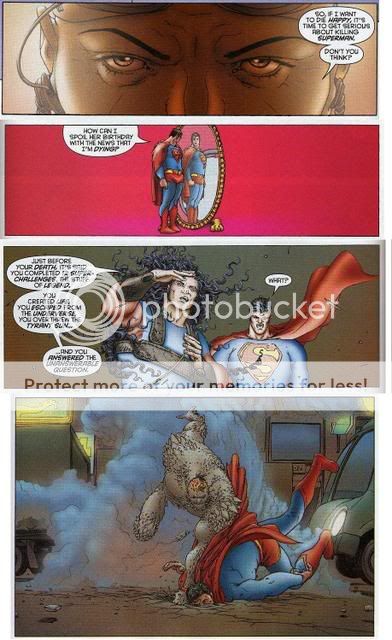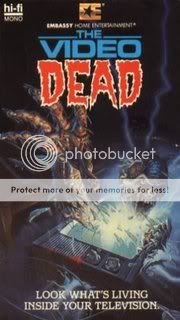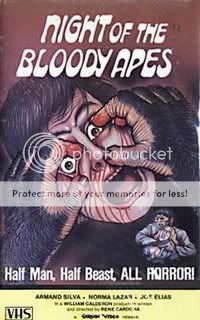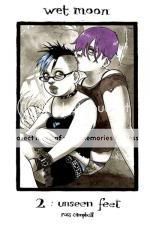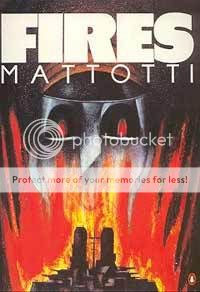Archive for September 8, 2008
Carnival of souls
September 8, 2008* Last week’s “Confessional” installment of Tom Spurgeon’s regular reader-participation feature Five for Friday, featuring twenty-five questions total from five different categories about nearly every comics-related topic under the sun (and some non-comics stuff too), was a real doozy to answer. Or so I thought, because I am an ignoramus and didn’t read the part that said you were only supposed to answer one question from each of the five five-question categories. Oh well, you can read all my answers here. And I don’t even feel so bad, because in misreading the topic I’m in the company of such comics luminaries as Paul Pope, Brandon Graham, and Richard Starkings.
* Douglas Wolk annotates Geoff Johns and Scott Kolins’s Final Crisis: Rogues’ Revenge #2. Kolins is easily the comics pro with whose name mine most often gets mixed up–our first names are monosyllabic and begin with an S, our last names sound exactly alike, and in many company email systems my address starts with “sco,” adding to the confusion. However, only one of us drew Weather Wizard blowing up someone’s torso with a miniature tornado.
* Ian Garrick Mason at Sans Everything notes the similarity between the United States’ current justifications for torture and those of the original Man of Steel, Josef Stalin.
* Finally (and with a little help from yours truly), Aeron Alfrey at Monster Brains reveals the origin of this evocative image…
Comics Time: Mome Vol. 12: Fall 2008
September 8, 2008Mome Vol. 12: Fall 2008
Kaela Graham, Sophie Crumb, Nate Neal, Ray Fenwick, Olivier Schrauwen, Dash Shaw, Tom Kaczynski, Al Columbia, Jon Vermilyea, Derek Van Gieson, Killoffer, Sara Edward-Corbett, David B., Paul Hornschemeier, writers/artists
Eric Reynolds and Gary Groth, editors
Fantagraphics, August 2008
120 pages
$14.99
I’m not a big underground comics person, particularly today’s derivatives thereof. Too much of it feels like schtick to me: using “th’ ” instead of “the,” bigfoot characters smiling and waving at you and saying “hiya!”, funny animals fuckin’…I dunno, maybe this is how people who are sick of superheroes feel about capes and masks and punching–that it’s just going through the motions while not really saying anything about anything. It’s mostly not for me, though there are those who can make it work by blowing it out into the ionosphere of savagery (Rory Hayes) or through trailblazing and raw, restless chops (Crumb). Its imitators have an even tougher go of it with me–there aren’t a lot of Marc Bells out there, you know?
Last time out with Mome, I thought I was starting to detect and undergroundward drift, and the recent announcement that Gilbert Shelton seemed to confirm that suspicion. So I was all frowny-faced when I read the first comics contribution to this issue, from Nate Neal, “Whadda grade ‘A’ maroon I been! All that pissin’ and moanin’ I do about the world goin’ to shit…” says title character Tender Henderson. It’s enough to send you screaming for your Big Brother and the Holding Company record. But suddenly Neal shifts gears to a finely observed relationship comic, and even if you’ve seen this sort of thing before, we’re clearly back in the far less hammy, frequently more rewarding territory of contemporary artcomix.
That’s where I’d prefer Mome to stay, and for the most part that’s where it is here. For the first time in a while there are a number of comics included that fail to make much of an impression one way or another, but the winners are real doozies. David B. contributes yet another rhapsodic blend of history and fantasy with his tale of sex, violence, and religious zealotry “The Drum Who Fell in Love.” Olivier Schrauwen, Al Columbia, and Dash Shaw all discomfited me mightily with their astute use of silent, nightmarish strangeness. Kaczynski is really on a roll with his examinations of modern life’s nuisances-cum-perils, focusing this time on the pervasiveness of noise. Killoffer and Jon Vermilyea each serve up a different blend of gross-out humor and disturbing violence, both capping them off with killer, laugh-out-loud final panels. And let’s be honest with ourselves, any place you can get new work from David B. and Killoffer between one set of covers is the kind of place you want to be.
Carnival of souls
September 5, 2008* This is the best idea the comics blogosphere as such has had in ages: Sandy Bilus at I Love Rob Liefeld tells the story of Grant Morrison & Frank Quitely’s All Star Superman in eleven panels, one per issue so far. It works! (Via Douglas Wolk.)
* G.I. Joe movie producer Lorenzo di Bonaventura opens his mouth and a veritable ocean of stupid pours out. Jiminy Christmas, they take my favorite toy line from when I was a kid, cast Joseph Gordon-Levitt as Cobra Commander, and the movie is still going to royally eat it. (Via Topless Robot, who, for their sins, compile some of the choicest idiocy.)
* Either Doug Wolk is pulling another Jess Lemon or extravagantly eyebrowed Art Brut frontman Eddie Argos actually is reviewing comics for a St. Louis-based entertainment website. He’s read Booster Gold and Tales from the Farm…twice! (Via Pitchfork.)
* Fight Club author Chuck Palahniuk apparently talked to DC Comics about doing a limited series. He’s also friends with David “Kabuki” Mack. That’s all I got.
* Eve Tushnet writes on abortion in horror, and discovers a surprisingly underutilized approach thereto. Worth a read even if (as is likely) you disagree with where Eve’s coming from on the issue, since her approach is descriptive rather than prescriptive (which is something I could stand to see more of in horror writing, as a matter of fact).
* Rich Juzwiak and Gabe Delahaye chat about Pier Paolo Pasolini’s anti-facist proto-torture-porn, er, classic?, Salò or the 120 Days of Sodom.
* This week’s installment of Awesome Movie Poster Friday over at Stacie Ponder’s Final Girl is all about VHS box art, and needless to say, it’s de-gorgeous.
Oooh, a sale!
September 5, 2008I meant to link to this yesterday, and you’ve probably seen it already anyway, but the wonderful publisher (and occasional patron of none other than Sean T. Collins) Top Shelf is having a terrific end-of-summer sale, wherein many of their books are marked down significantly and some are reduced to just three bucks! Click here and shop.
Comics Time: Wet Moon Book 2: Unseen Feet
September 5, 2008Wet Moon Book 2: Unseen Feet
Ross Campbell, writer/artist
Oni Press, June 2006
180 pages
$14.99
College is the time in everyone’s life when maximum personal freedom meets minimum personal responsibility. Classes and grades notwithstanding, there’s really nothing to stop you from doing pretty much whatever you want, whenever you want, in a parentless, highly sexed world where you are generally rewarded for following your bliss. I mean, at least this was how it was when you were a film studies major. It also seems to be how it is for the art students who populate Wet Moon, Ross Campbell’s languid goth soap opera. As is the case with those heady times before you’ve picked a major, or perhaps toward the end of your four years when you’ve basically completed all your requirements and have maybe four hours of classes every seven days, the kids in Wet Moon seem to neither know nor care where they’re going, simply soaking in the atmosphere of aimlessness. I can’t remember the last time I read a comic this visually (and aurally–the dialogue is spot-on) ambitious while having so little an idea of where that ambition was eventually going to take me. I don’t know how you’d feel about it, but I’m loving the experience. For one thing, it allows Campbell’s art to shine almost as an end in itself. It’s not just that his line is lovely or that his character designs are each unique and memorable or that his characters are basically all super-sexy in this delightfully slatternly way, though all these things are true; he also makes very smart choices in terms of choreography, body language, and pacing that really stick. When lead character Chloe accidentally mispronounces a pair of words in the middle of an argument, the look of self-irritation on her face is pricelessly accurate. There’s a great sex scene where the interplay of insecurity and self-confidence among young people is conveyed deftly and appealingly, but Campbell can also deflate his characters’ romantic presentations, as when he transforms Chloe’s memory of getting dumped by her beautiful ex-boyfriend Vincent into an over-the-top parody of goth sentimentality. And then there are random-ass scenes like some sort of reverie/dream sequence/I don’t know what involving a character drinking orange juice out of the carton, wandering into the street, and rolling one eye up into her head. What a weird, addictive series this is.
Carnival of souls
September 4, 2008* Clive Barker decries PG-13 horror as insufficiently dangerous. B-Sol quibbles.
* Related: John Harrison, director of the upcoming Barker adaptation Book of Blood, refers to the film as more character-driven than splatteriffic. (Via Bloody Disgusting.)
* Matthew Perpetua links to an old Hard Copy story on that time the FBI mistook part of the video for Nine Inch Nails’ “Down in It” for a snuff film. That never happened to Stabbing Westward.
* Douglas Wolk annotates Grant Morrison and Dough Mahnke’s event comic/Supermen team-up/Watchmen fanfic Final Crisis: Superman Beyond #1.
* My experience with RPGs is limited to one lovely, beery summer between freshman and sophomore year in college, but I still found Bruce Baugh’s look at early D&D guidebooks fascinating as an examination of how imagination and play can be given structure and stricture of varying efficacy.
Comics Time: Clive Barker’s The Thief of Always
September 3, 2008Clive Barker’s The Thief of Always
Kris Oprisko, writer
Gabriel Hernandez, artist
adapted from the novel The Thief of Always by Clive Barker
IDW, 2005
144 pages
$19.99
Given the standard weakness of comics adaptations of non-City of Glass prose material and the standard cheesiness of American horror-comic art, any project that entails adapting a prose horror novel would normally already have two strikes against it. But Clive Barker has gotten lucky on that score a few times during his career, from the impressively atmospheric Books of Blood-based anthology series Tapping the Vein back in the day to this little number based on Barker’s first all-ages book. While you can see the rough edges in the edits quite frequently–most notably during the beginning and ending, which are rushed enough to feel like they happen how they do because they must, not because that’s what springs from the events that befall the characters and emotions they experience as those events take place–it’s a surprisingly evocative, beautifully illustrated little graphic novel about a childhood lost.
The story concerns a schoolkid named Harvey Swick who, bored to tears by a dreary February, is approached by a magical being with a beyond-ear-to-ear grin, named Rictus. (Already a good sign, right?) Rictus offers Harvey a vacation to a place called the Holiday House, whose mysterious proprietor Mister Hood offers “special” children an eternity of carefree carousing, with each day in the place comprising all four seasons of the year. (Every morning is springtime, while it’s Halloween every evening and Christmas every night.) Needless to say things aren’t what they seem, and before long Harvey and the friends he makes at Holiday House try to escape this lotus-eating interval to return to the outside world, which turns out to be tougher than it looks.
While the book tends now to be compared to Harry Potter, it has a lot more in common with other stories of childhood voyage and return to a dangerous land of fantasy: Oz, Wonderland, Never-Never Land, and Barker’s own Abarat. The idea of the haunted house–since that’s obviously what we’re dealing with–also hits notes resonant with everything from Hansel & Gretel to The Shining, not to mention Candyman director Bernard Rose’s Paperhouse, a more-or-less contemporary product of the British dark fantasy scene, iirc. Aside from the obviously truncated start and finish to the story, Oprisko does a solid job of preserving as much of Barker’s weird whimsy as possible, making sure to include moments that stand out from the fairy-tale norm–Harvey’s phone calls home to his parents to make sure they’re okay with his vacation, for example.
The real star of the adaptation, though, is Gabriel Hernandez and his absolutely lovely art. It appears to have been done in pencil, then given a soft bath in muted color washes by Sulaco Studios. The contrast between Hernandez’s off-kilter, frequently angular character designs and Sulaco’s gauzy palette is pretty much perfect for Barker’s kids’ fantasy work, which itself introduces elements of the horrific into a storytelling mode we’re frequently quite cozy with. Hernandez is as attentive to detail as he is to design–for example, quietly filling the Holiday House with everything a boy could wish for, from suits of armor to Egyptian sarcophagi to preserved pterodactyls, despite this never being referred to in the dialogue. It’s the art that will keep me coming back to this one, and makes it worth at least a first look.
Carnival of souls
September 2, 2008* To the extent that you care about the blend of enthusiasm and unease this blog occasionally displays for displays of hypermasculinity, you are advised to download and listen to Matthew Perpetua’s best-of mix for mock-cock-rock geniuses the Electric Six. You probably are familiar with their songs “Gay Bar” and “Danger! High Voltage,” but that truly is just the tip of the iceberg for their oeuvre of awesomely accurate lampoons of macho insecurity. The mix even includes songs from their not-yet-released fifth album Flashy, so go and enjoy the sound of the future.
* Tom Spurgeon has done another of his always-worth-reading slush-pile review marathons. This one includes his takes on the rewardingly bizarre Water Baby by Ross Campbell, some Johnny Ryan minicomics, the latest MOME, and, in a review that contains compliments so awesomely backhanded they’ll make your face ache, Comic Foundry.
* Chuck Palahniuk says his first more or less openly horror novel Lullaby is headed to the big screen. Chuck Palahniuk is not the most reliable source of information regarding movie versions of his books, but hey. (Via Bloody Disgusting.)
* Aaron “Chief Galen Tyrol” Douglas says Battlestar Galactica‘s final episodes won’t start airing till April, rather than the originally announced January start date. (Via AICN.) SciFi Channel says au contraire–the January start date is on as planned.
* The very good comics and art publisher PictureBox is having a deep-discount sale on everything in its store this week. Unsurprisingly, I bought a T-shirt.
* Curt Purcell of The Groovy Age of Horror continues his series of essays critiquing–even “debunking,” in Curt’s words–Freud’s seminal essay “The Uncanny,” one of the core texts for scholars of horror. This time out he argues that the supernatural isn’t scary because of how it indicates the return of the repressed, but that the return of the repressed is scary because it indicates the presence of the supernatural. Total protonic reversal!
* CRwM of And Now the Screaming Starts has been taken a lengthy, YouTube-enhanced look at each of Coney Island’s three haunted-house rides. View at your own risk!
Comics Time: Fires
September 1, 2008Fires
Lorenzo Mattotti, writer/artist
Penguin, 1991
64 pages
I’ve had this book for a long long time, acquiring it through Sequential Swap because hey, Lorenzo Mattotti, right? One of the great comics artists in the world! But I’ve put off reading it for just as long because the great comics art inside it is, if I’m being honest, not for me. I don’t see people in Mattotti’s blocky, quasi-cubist painted figures, I see blocks. With its tactile layers of color covering every inch, I have a hard time finding an “in” to any given panel. My eye just bounces right off the surface.
The funny thing is that the story almost overcomes this. It stars one Lieutenant Absinthe, an officer in the navy of a South American archipelagic country whose battleship is sent on a mission to investigate the mysterious island of Saint Agatha, where ships seem to go missing with alarming regularity. In an arc that should be familiar to fans of everything from The Lord of the Flies to Lost to The Shining, Absinthe–heh, here I was going to say “slowly” out of sheer force of habit, but it happens almost overnight–goes native, and ends up helping the supernatural (?) forces present on the island destroy his comrades. On the back cover, a blurb from Mattotti indicates that his inspiration was the films of Tarkovsky and Herzog and the hypnotic power of their environments; in essence, Mattotti’s project was to craft a story that does what his art fails to do with me, which is suck one in. He works so hard at it that he almost pulls it off–the story’s climax in particular is vividly done–and the countless similar stories you’ve read or seen do some of the work for him, but ultimately I keep running into that wall of visual information over and over again and finding no way to join Lieutenant Absinthe as he’s pulled in.


